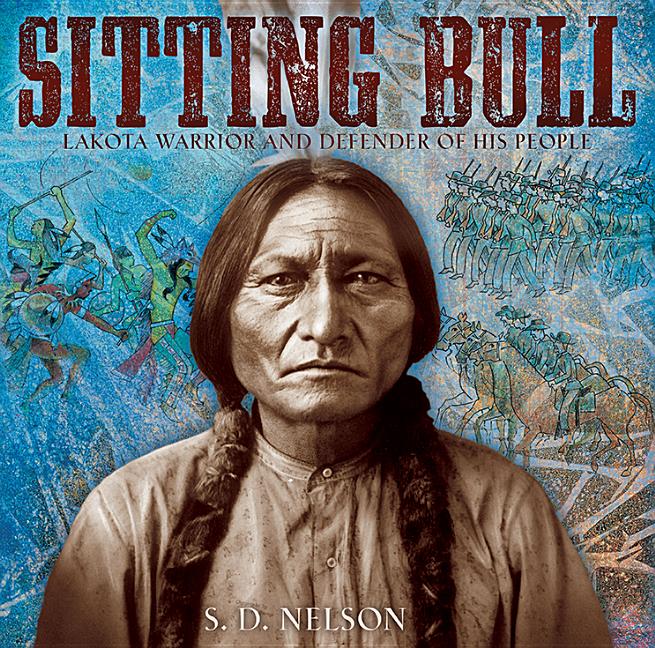Book Descriptions
for Sitting Bull by S.D. Nelson
From Cooperative Children's Book Center (CCBC)
In a fictionalized first-person voice, Nelson offers a powerful, moving narrative of the life of the great Hunkpapa Lakota leader, Sitting Bull. By juxtaposing Sitting Bull’s early life with the presence of the U.S. government troops at the beginning of the book, Nelson introduces the conflicts and contradictions that plagued Sitting Bull throughout his life. Before his birth, the wasichus, or white men, disrupted the Lakota lands and lives. Still, young Sitting Bull grew up in the traditions of his people to become a strong, honorable warrior. Sitting Bull was keenly aware of the “two faces” of wasichus who offered one thing and provided another much worse option. As a leader, Sitting Bull made every effort to protect his people from this and avoided signing treaty rights. When Sitting Bull could no longer protect his people and stave off the government, the tragedy is palpable as he becomes what he once hated: an Indian relying on government handouts. He is ultimately murdered for still being held in such high regard by his people. Integrating ledger-book art, an art form that originated during the last part of the 19th century by Native American artists using discarded ledger books, and weaving together quotes, photographs, illustrations, and prose, Nelson creates a dynamic, engaging biography of Sitting Bull and a welcome perspective on this history. Detailed notes with a timeline and a more personal author’s note are included. (Ages 8–12)
CCBC Choices 2016. © Cooperative Children's Book Center, Univ. of Wisconsin - Madison, 2016. Used with permission.
From the Publisher
An inspiring picture book biography of the Lakota/Sioux warrior and chief Sitting Bull, from award-winning author and illustrator S. D. Nelson
Sitting Bull (c. 1831–1890) was one of the greatest Lakota/Sioux warriors and chiefs who ever lived. He was eventually named war chief, leader of the entire Sioux nation—a title never before bestowed on anyone. As a leader, Sitting Bull resisted the United States government’s attempt to move the Lakota/Sioux to reservations for more than twenty-five years.
From Sitting Bull’s childhood—killing his first buffalo at age ten—to being named war chief, to leading his people against the U.S. Army, and to his surrender, Sitting Bull: Lakota Warrior and Defender of His People brings the story of the great chief to light. Sitting Bull was instrumental in the war against the invasive wasichus (White Man) and was at the forefront of the combat, including the Battles of Killdeer Mountain and the Little Bighorn. He and Crazy Horse were the last Lakota/Sioux to surrender their people to the U.S. government and resort to living on a reservation.
Award-winning author and member of the Standing Rock Sioux tribe S. D. Nelson intersperses archival images with his own artwork, inspired by the ledger-art drawings of the nineteenth-century Lakota. Through the art and riveting story, Nelson conveys how Sitting Bull clung to his belief that the Lakota were a free people meant to live, hunt, and die on the Great Plains.
Sitting Bull (c. 1831–1890) was one of the greatest Lakota/Sioux warriors and chiefs who ever lived. He was eventually named war chief, leader of the entire Sioux nation—a title never before bestowed on anyone. As a leader, Sitting Bull resisted the United States government’s attempt to move the Lakota/Sioux to reservations for more than twenty-five years.
From Sitting Bull’s childhood—killing his first buffalo at age ten—to being named war chief, to leading his people against the U.S. Army, and to his surrender, Sitting Bull: Lakota Warrior and Defender of His People brings the story of the great chief to light. Sitting Bull was instrumental in the war against the invasive wasichus (White Man) and was at the forefront of the combat, including the Battles of Killdeer Mountain and the Little Bighorn. He and Crazy Horse were the last Lakota/Sioux to surrender their people to the U.S. government and resort to living on a reservation.
Award-winning author and member of the Standing Rock Sioux tribe S. D. Nelson intersperses archival images with his own artwork, inspired by the ledger-art drawings of the nineteenth-century Lakota. Through the art and riveting story, Nelson conveys how Sitting Bull clung to his belief that the Lakota were a free people meant to live, hunt, and die on the Great Plains.
Publisher description retrieved from Google Books.


